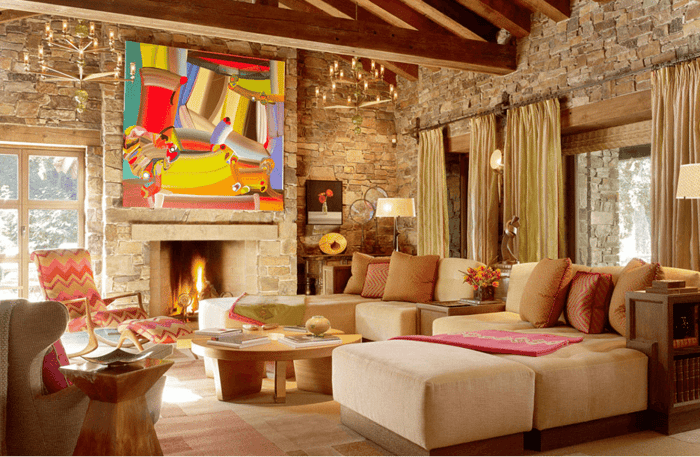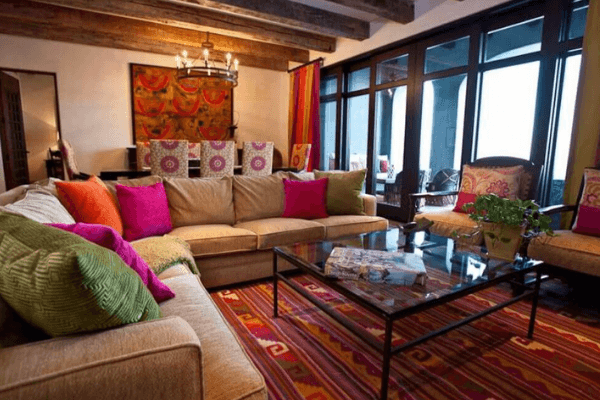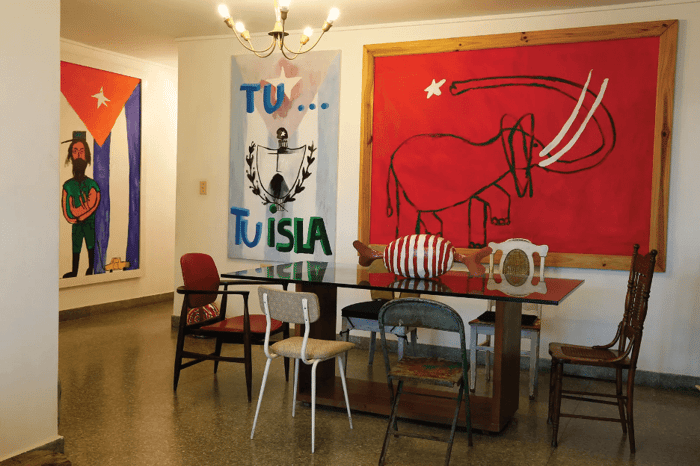Spain is an incredibly diverse country, with a multitude of influences, even defined as many countries within a country. The design style that runs through the whole nation though can be summarized as vibrant, passionate, and full of color. Plus a definitive sense of antiquity, old-fashioned values stemming from strong foundations in family traditions. The combination of the Mediterranean, French country, Tuscan, and Moroccan influences can be felt in a variety of home decor details and interior structures.
 Colors
Colors
It’s a bit challenging to pin down a color palette when decorating a Spanish home as there are so many variations and can be quite diverse. The choices may be narrowed down to these combinations and tones:
Natural earth hues, using shades in both the warm and cool browns.
- Taupe and chocolate browns.
- Warm yellows, terracotta, and burnt oranges.
- Passionate, deep reds.
- Indigo blues and nature inspired greens.
- Crisp white, making the perfect backdrop for the many ornate Spanish accents and decorative elements.
 Floors
Floors
Due to the hot moist weather of Spain, flooring preferences run towards hard surfaces versus any wall-to-wall carpet.
- Ceramic tiles in a matte finished look
- Hardwoods
- Slate
- Terracotta tiles with dark grout
Placing Spanish style throw rugs on top creates a well-balanced look and feel. The traditional rugs from this area are woven in a knotted pattern with staggered row designs. Generally colors will be in the neutral lighter shades of beiges and off-whites.

Furniture
Furniture pieces in the Spanish-Mediterranean style interiors tend to be primarily made of solid, dark colored woods or leather in deep shades of brown. Furnishings take on classical design shapes with straightforward function in mind. The look is heavy, large, and massive, with bits of artistic carvings here and there. Spanish-style homes also use Mission-style dark, distressed wood furnishings. This more traditional model of furniture is the necessary contrast to the architectural elements that are often found in Spanish homes. For example, ornately carved wood panels and rounded arches with whimsical decorative carvings are not uncommon in this decor style. Additional traditional elements:
- Solid woods: ebony, mahogany, rosewood, teak, & walnut.
- Wooden benches.
- Straight-backed armchairs.
- Upholstery in woven cotton fabrics using dense textures.
- Rounded arches to room entrances with inspired wood carvings.
- Fireplace, adding the perfect warm and cozy contrast to the other heavier elements.

Accents
A Spanish style home is devoted to hosting an array of bright accents in materials of ceramic, clay, copper, earthenware. The ornamentation of wrought iron is essential to the look as well. Add some Mediterranean style fabrics to the mix and now the scene is set.

Wrought Iron: this traditional element can be brought in with lighting selections, such as a chandelier, wall sconces, or table lamps. It also works well in decorative details on furniture, stair railings, door knockers, and cabinet handles. In the bedroom, add it with the installation of a canopy bed frame, headboard, or curtain rods. This metal accent really enhances the thematic look in any room of the house.
 Ceramics: traditional earthenware makes a bold appearance in decorative accents all over the home. From vases, to wall art, to furnishing the table settings, simple terracotta to brightly colored pieces are definitely a necessary addition when decorating in Spanish style. This artistic pottery can be grouped in small gatherings or larger individual statement pieces displayed in kitchens, living rooms, and outside sitting areas.
Ceramics: traditional earthenware makes a bold appearance in decorative accents all over the home. From vases, to wall art, to furnishing the table settings, simple terracotta to brightly colored pieces are definitely a necessary addition when decorating in Spanish style. This artistic pottery can be grouped in small gatherings or larger individual statement pieces displayed in kitchens, living rooms, and outside sitting areas.
 Talavera Tiles: or painted tiles were named after the Spanish craftsmen from the town of Talavera DeLa Reina in Spain who were the experts in creating these exquisite ceramics. Talavera tiles are usually placed in Spanish style kitchens, bathrooms, and as decorative framing around fireplaces.
Talavera Tiles: or painted tiles were named after the Spanish craftsmen from the town of Talavera DeLa Reina in Spain who were the experts in creating these exquisite ceramics. Talavera tiles are usually placed in Spanish style kitchens, bathrooms, and as decorative framing around fireplaces.

 Textiles
Textiles
In contrast to the heavy, dark wood of Spanish furniture, the fabrics and textiles are woven in mostly colorful checkered and ethnic patterns. Used in bedroom canopies, as woven throws on chairs, brightly colored throw pillows, and area rugs, these woven pieces add warmth and comfort. Windows are adorned in treatments of natural woven curtains in tones of muted neutrals or clean whites.
 Patio Areas
Patio Areas
The extended family and community lifestyle of Mediterranean living means much social engagement, inside and outside around the home. Most Spanish homes have extended living areas such as patios, verandas, and terraces. Meaning that any outdoor space needs to be included in your decorating efforts just as if it’s an extension of the interior. The feel needs to be welcoming and made for extended visiting. Add colorful cushions to your outdoor furniture; a fire pit; lush greenery in terracotta pots plus any other decorative accents to make your outdoor areas offer an embracing vibe.
 Kitchen: Family and food go hand-in-hand with Spanish culture. Thus it can easily be said that life in a Spanish home centers around the kitchen. This makes the cooking area prominent and usually quite large. The decorative style is warm and inviting, lending itself to a look and feel that can be both contemporary and traditional, depending on your personal taste. White walls set off terracotta floors, dark wood cabinetry, and painted tile accents.
Kitchen: Family and food go hand-in-hand with Spanish culture. Thus it can easily be said that life in a Spanish home centers around the kitchen. This makes the cooking area prominent and usually quite large. The decorative style is warm and inviting, lending itself to a look and feel that can be both contemporary and traditional, depending on your personal taste. White walls set off terracotta floors, dark wood cabinetry, and painted tile accents.
- Flared Range Hood- a quite common feature in Spanish style kitchens is the flared range hood, which is traditionally made from stone, copper, or other metals. Decorative ornamentation is usually added to this appliance as well.
- Materials- terracotta, stone, forged metals with rustic finishes, and hard wood are all classic Spanish kitchen materials. These clay colored tones are perfect for creating warmth. Terracotta blends beautifully with the wood, making matching cabinet selection an easy task.
- Wrought Metals- of iron and bronze in cabinet handles, door knobs, and door hinge accents adds that feel of ancient charm from olden times.
- Seating Textiles- sitting areas in the kitchen, whether in bar stools, small corner tables, benches, or breakfast nook areas, are usually covered in natural textile elements using agave fibers, wicker, or sturdy woven cotton.
- Painted Tiles- as previously mentioned, ornately painted tile work is almost always seen in Spanish style kitchen backsplashes or as drawer handles accents.
 Summary
Summary
Spanish interior design style is grounded in bold furnishings, bright colors, an open airy design, and artistic accents from all corners of the Mediterranean region. It is functional, simple, and comfortable, embracing classic family traditions. It reminds us of a simpler time. An easy style to incorporate into your home with dark wood furniture, painted tiles and ceramic accents. A dash of wrought iron and festive textiles will bring this vibrant European style to life.

#mexicanart #art #artemexicano #arte #mexicanartist #handmade #artecontemporaneo #mexicanculture #mexicanstyle #homedecor #interiordesign #home #interior #decor #design #homedesign #handmade #homesweethome #decoration #furniture #interiors #architecture #homedecoration #vintage #interiordesigner #interiordecor








